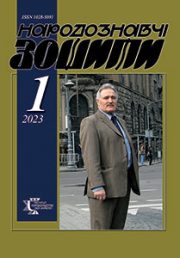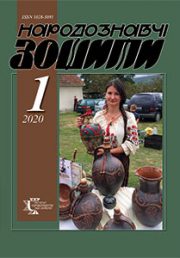The Ethnology Notebooks. 2023. № 6 (174), 1348—1353
UDK [391.4:687.241-037](477.8+474.5)”18/19″:001.891
DOI https://doi.org/10.15407/nz2023.06.1348
WOMEN’S PATTERNED SHIRTS OF THE WESTERN PART OF UKRAINE AND LITHUANIA: A COMPARATIVE ASPECT
NYKORAK Оlena
- ORCID ID: https://orcid.org/0000-0003-0887-8929
- Doctor in Art Studies, Professor,
- Leading Researcher,
- Ethnology Institute of the National Academy of Sciences of Ukraine,
- Folk Art Department
- 15, Svoboda Avenue, 79000, Lviv, Ukraine,
- Contacts: e-mail: olenanykorak@gmail.com
KUTSYR Tetiana
- ORCID ID: https://orcid.org/0000-0002-6522-0640
- Candidate of Art Studies (Ph. D.)
- Researcher,
- Ethnology Institute National Academy of Sciences of Ukraine,
- Folk Art Department
- 15, Svoboda Avenue, 79000, Lviv, Ukraine,
- Contacts: e-mail: sonechko_29@ukr.net
Abstract. The article is devoted to the study of the features of patterned women’s shirts in the western part of Ukraine and Lithuania based on the results of the Ukrainian-Lithuanian interdisciplinary scientific projects «Ornamentation of Western Ukrainian and Lithuanian Folk Textile: Universal and Unique Parameters» (2018—2019) and «Unique Technologies of Ethnographic Textile: Experience of Preservation in Western Ukraine and Lithuania» (2022). The relevance and novelty of the chosen topic are determined by its insufficient coverage in the art history and ethnological literature of both countries.
The article`s purpose is to reveal common and different approaches in the application of making techniques and the artistic and stylistic features of the decoration of Western Ukrainian and Lithuanian patterned women’s shirts determined by them.
The object of the study is patterned women’s shirts traditional in the western part of Ukraine and Lithuania, and the subject is the common and distinctive features of their decor.
The main study method was a comparative analysis, which made it possible to reveal the characteristic features of patterned women’s shirts of both countries at the end of the 19th and the first half of the 20th centuries based on the comparison of their technological and decorative parameters. Historical and art history methods made it possible to follow the dynamics of changes in the techniques and decoration of products caused by socio-political and economic factors. The structuring of the obtained results was carried out using the typological method with the selection of similar and different groups of patterned women’s shirts from both countries.
Results. The use of weaving as the main decoration of women’s shirts was widespread in all historical and ethnographic regions of Lithuania during the 19th and early 20th centuries. In Ukraine, patterned women’s shirts were widespread in the western part of Polissia, in the Volyn region, in separate areas of Lemko, Kholm, and Pidliashshia, Pokuttia, and Pidhiria regions. Linen and cotton were used in both countries to make shirts, and hemp and wool were also used in Ukraine. The cut of the shirts differed significantly: in Ukraine «ustavka» cut predominated, in Lithuania — the so-called tunic-like «strilkova». The location of the ornamental stripes also differed. For Ukraine, it was typical to decorate the shoulder and sub-shoulder line, while in Lithuanian shirts the shoulder part was not highlighted, the lower part of the sleeve was more often decorated. For Ukrainian items, a combination of several weaving techniques is inherent, often plain, twill, rip weaving, and pick-up technique, for Lithuania — plain weaving with pick-up technique.
In the complex of traditional clothing, the meaning of a patterned shirt varied somewhat. In the ensemble of Ukrainian regions, the shirt was often the compositional center, while in Lithuanian it was perceived as an addition to brighter, colorful and decoratively saturated skirts, aprons, and corsets. The northern location of Lithuania and the cooler climate led to wider use of outerwear throughout the year, from under which the shirt, except for the collar and cuffs, was not visible.
Keywords: Ukraine, Lithuania, weaving, shirt, patterned, decor, ornament, composition, color.
Received 10.11.2023
REFERENCES
- Kumpikaite, E., Nykorak, O., Nenartaviciute, E., Herus, L., Kutsyr, T., Milasiene, D., Kozakevych, O., Rukuiziene, Z. (2023). Comparative Analysis of Western Ukrainian and Lithuanian Folk Towels. Fiber & Textile in Eastern Europe, 2 (31), 26—38.
- Biletska, V. (1929). Ukrainian Shirts, Their Types, Evolution and Ornamentation. Materials for Ethnology and Anthropology (Vol.~XXI—XXII, part~1, pp.~43—109). Lviv: Drukarnia Naukovoho tovarystva imeni Shevchenka [in Ukrainian].
- Mateiko, К. (1977). Ukrainian Folk Clothing. Kyiv: Naukova dumka [in Ukrainian].
- Kara-Vasylieva, T. (2008). History of Ukrainian Embroidery. Kyiv: Mystetstvo [in Ukrainian].
- Bulhakova-Sytnyk, L., & Lozynskyi, T. (Eds.). (2018). Bukovyna Region Women’s Shirts. Album. Kyiv: Maister knyhy [in Ukrainian].
- Sydorovych, S. (1979). Artistic Fabric of the Western Regions of the Ukrainian SSR. Kyiv: Naukova dumka [in Ukrainian].
- Nykorak, О. (2009). Fabrics for Patterned Women’s Shirts of the Western Part of Ukrainian Polissia and Volyn Regions. The Ethnology Notebooks, 3—4, 345—365 [in Ukrainian].
- Ukraiinets, A. (2019). Traditional Clothing of the Rivne Region. Volume 1. Rivne: U farvateri istyn.
- Bernotiene S. (1974). Lithuanian Folk Women’s Clothing of the XVIII—XX Centuries. Vilnius: Mintis [in Lithuanian].
- Jurkuviene, T. (2006). Lithuanian National Costume. Vilnius: Baltos lankos [in Lithuanian].
- Bernotaite-Beliauskiene, D., Rutkauskiene, R. (Eds.). (2017). Lithuanian Traditional and National Clothes: Textiles, Graphics, Painting. Vilnius: Lietuvos dailes muziejus [in Lithuanian].
- Nenartavisoute, E., Noreikyte, R., Tomkuviene, D., Vandyte, A. (Eds.). (2021). Shirts Closer to the Body. Sudarytojos: Lietuvos liaudies buities muziejus [in Lithuanian].
- Nykorak, О., Kutsyr, Т., Yusypchuk, Yu., & Bilyi, V. (2022). Female Patterned Sorochkas (Shirts) from the Pidhiria Region. The Ethnology Notebooks, 6 (168), 1419—1431 [in Ukrainian].






